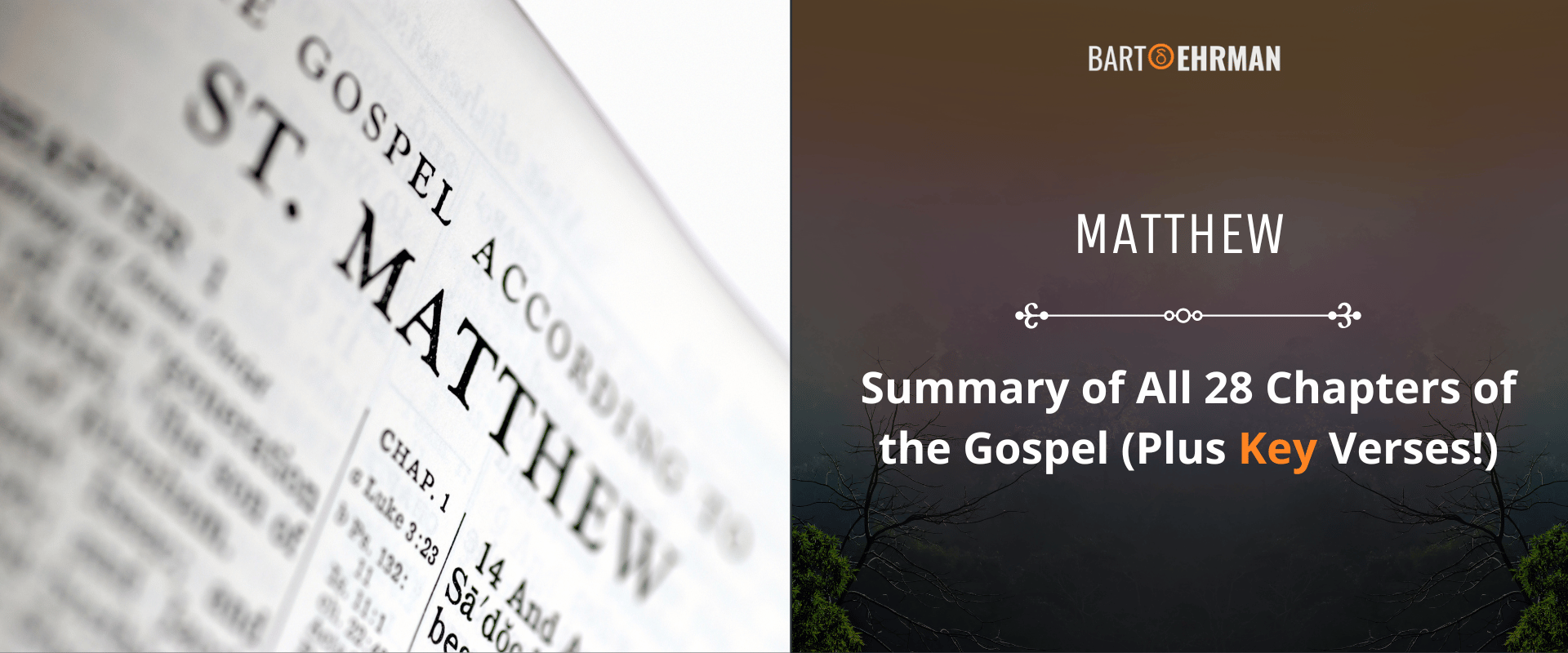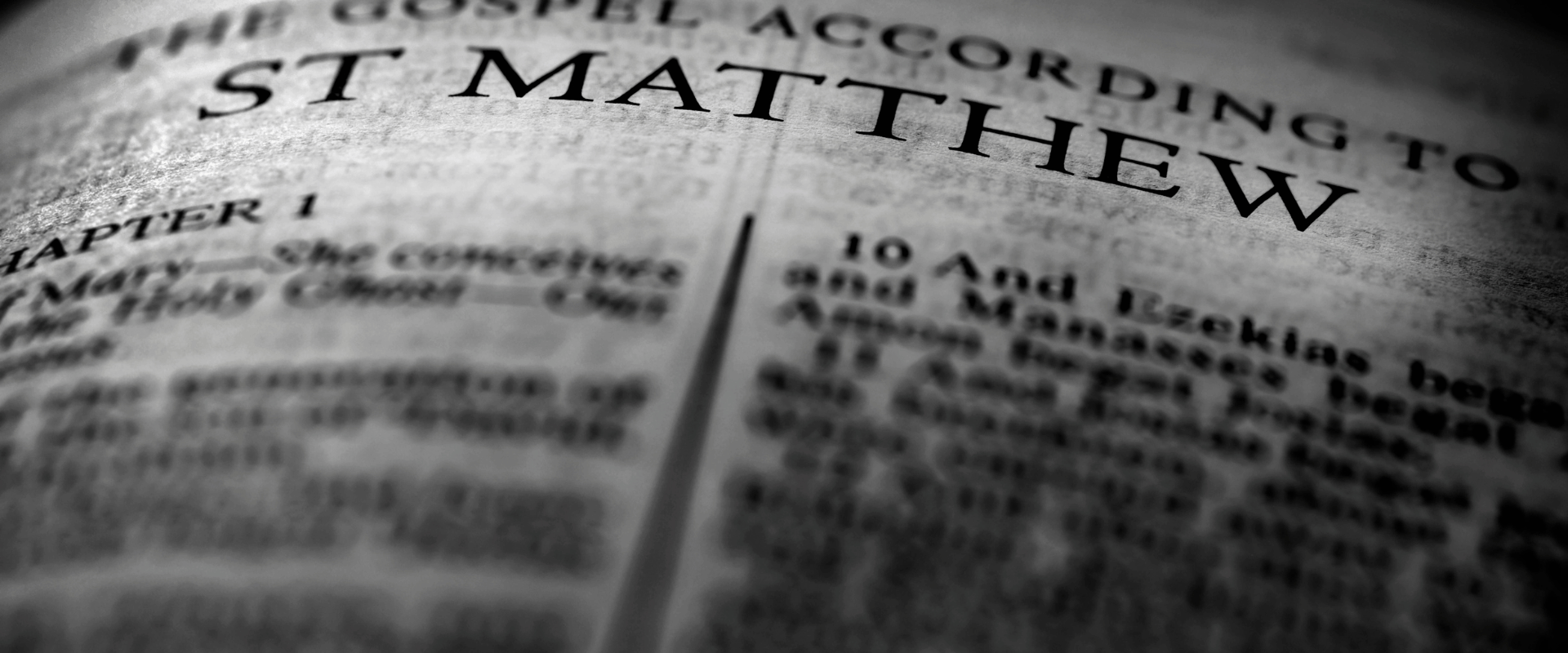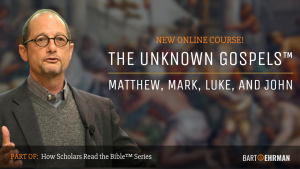Matthew: Summary of All 28 Chapters of the Gospel (Plus Key Verses!)

Written by Joshua Schachterle, Ph.D
Author | Professor | Scholar
Author | Professor | BE Contributor
Verified! See our editorial guidelines
Verified! See our guidelines
Date written: July 10th, 2024
Disclaimer: The views and opinions expressed in this article belong to the author and do not necessarily match my own. - Dr. Bart D. Ehrman
The Gospel of Matthew, a cornerstone of Christian Scripture, depicts the life and teachings of Jesus of Nazareth. In addition, it displays a deeply rooted Jewish identity. This cultural and theological backdrop not only informs its content but underscores Matthew's intended audience — likely a Jewish-Christian community navigating their faith amidst broader societal and religious changes.
In this article, I’ll give some brief information about Matthew’s date of composition and thematic content, then jump into a summary of the book, chapter by chapter.
Meanwhile, here’s a brief preview of the key events in the Gospel of Matthew:

When, Where, and Why Was Matthew Written?
Although people have long called this biographical portrait of Jesus the Gospel of Matthew, that title was not original to the book. In fact, like all the canonical Gospels, it was written anonymously with no title. Scribes eventually added the current title decades after the original text was written.
Walter Wilson, in his commentary on Matthew, suggests the author did not think of his writing as the work of an individual but rather as a reflection of his Jesus-following community. With that in mind, Matthew’s intended audience was almost certainly members of his own Jewish-Christian community.
In the Jewish Annotated New Testament, Aaron Gale says the book of Matthew was written between 80 and 90 CE, probably in Antioch, Syria, about six decades after Jesus’ death. (Affiliate Disclaimer: We may earn commissions on products you purchase through this page at no additional cost to you. Thank you for supporting our site!) How do they know this? First, the text refers multiple times to the destruction of the temple in Jerusalem (22:7, 21:41, 22:4, 23:38). This happened in 70 CE, so Matthew was written after that date.
Additionally, Bart Ehrman notes that Matthew’s author used the Gospel of Mark as one of his main sources. Mark was written around 70 CE, so Matthew had to be written later than that.
Finally, our earliest written reference to the Gospel of Matthew after the writing of the New Testament is in letters dated around 110 CE from a bishop of Antioch named Ignatius. The book of Matthew must have been written before that date.
What is the book of Matthew about? In terms of content, it is the most Jewish of the four canonical Gospels in several ways. First, the genealogy of Jesus mentioned at the beginning of the Gospel connects him directly to the Jewish patriarchs Abraham, Isaac, and Jacob, as well as David, Israel’s greatest king.
Second, in addition to numerous references to the Hebrew Bible in the text, Matthew’s Jesus insists on the importance of Torah observance. All of this points to a Jewish author for Matthew.
What is the meaning of Matthew? The author’s main emphases include Torah observance, faithfulness to Jesus despite persecution, the impending appearance of the kingdom of heaven, group harmony, and the last judgment.
Below is a chart summarizing the entire Gospel of Matthew. To learn more about Matthew, consider Bart Ehrman’s new course “The Genius of the Gospel Of Matthew - What Scholars Say About the First Gospel.”
FREE COURSE!
WHY I AM NOT A CHRISTIAN
Raw, honest, and enlightening. Bart's story of why he deconverted from the Christian faith.
Over 6,000 enrolled!
Chapter | Contents | Theme | Key Verse |
|---|---|---|---|
1 | Genealogy and Birth of Jesus. | Jesus’ background shows he is the Messiah. | 1:1 |
2 | Infancy stories of Jesus. | Jesus’ birth, the Magi, Massacre of Innocents. | 2:23 |
3 | John the Baptist baptizes Jesus. | Jesus’ ministry divinely authorized at his baptism. | 3:17 |
4 | Jesus is tested and begins his ministry. | Jesus’ preaching and healing validate his ministry. | 4:24 |
5 | Jesus begins the Sermon on the Mount. | Jesus is the righteous teacher of Torah. | 5:17 |
6 | Sermon on the Mount continued. | Teachings on prayer, fasting, and not worrying. | 6:34 |
7 | Sermon on the Mount continued. | Teachings on judging, Golden Rule, Narrow Gate. | 7:21 |
8 | Jesus heals people and stills a storm. | Jesus’ messiahship validated through miracles. | 8:16-17 |
9 | Jesus heals many and brings a dead girl back to life. | Jesus shows his divine power through healings. | 9:6-7 |
10 | Apostles’ mission and Jesus’ warnings. | Jesus sends disciples to proclaim the gospel. | 10:16 |
11 | Praise of John the Baptist, woe to unrepentant cities. | Jesus affirms he is the Messiah. | 11:4-5 |
12 | Jesus addresses the Sabbath and Pharisaic accusations. | Jesus on what is lawful on Sabbath. | 12:7-8 |
13 | Jesus’ parables and rejection at Nazareth. | Jesus explains kingdom of heaven through parables. | 13:10-11 |
14 | Death of John the Baptist, Jesus performs more miracles. | John the Baptist executed. Jesus feeds 5,000. | 10:26-27 |
15 | Debates with Pharisees, healings, feeding 4,000. | Jesus argues with Pharisees as Torah teacher. | 15:10-11 |
16 | Jesus denounces Pharisees and Sadducees, foretells death. | Jesus demonstrates authority to other religious leaders. | 16:21 |
17 | Transfiguration, exorcism, and the Temple tax. | Jesus shows true identity to three disciples. | 17:2-3 |
18 | Jesus speaks about temptation and forgiveness. | Jesus: those who tempt others will suffer. | 18:21-22 |
19 | Teachings about divorce and the danger of riches. | Jesus forbids divorce, says wealthy can’t enter kingdom. | 19:24 |
20 | Parable of the laborers, a mother’s request. | Jesus: whoever would be greatest must serve. | 20:26-27 |
21 | Triumphal entry, cleansing of the temple, parables. | Jesus lauded as a king entering Jerusalem. | 21:10-11 |
22 | Parable of wedding banquet, questions about taxes. | Jesus says all welcome in God’s kingdom. | 22:9 |
23 | Jesus denounces scribes and Pharisees. | Jesus criticizes the Pharisees for being hypocrites. | 23:13 |
24 | Predictions of persecution and destruction. | Jesus predicts the destruction of the temple. | 24:9 |
25 | Parables and Judgment Day. | Jesus: stay alert, God’s kingdom is coming. | 25:34-35 |
26 | Last Supper, Jesus’ arrest, Peter’s denial. | Jesus arrested, Peter denies knowing him. | 26:26-28 |
27 | Jesus is brought before Pilate. | Jesus is crucified and buried. | 27:46 |
28 | Jesus is resurrected, appears to women and disciples. | Jesus’ tomb empty, he appears to disciples. | 28:19-20 |

Conclusion
The Gospel of Matthew provides us with a particularly Jewish perspective on Jesus’ messiahship. In this book, Jesus is shown to be a unique interpreter of Torah, indicating that the author and his intended audience were Jewish Christians.
Scholars place the composition of Matthew between 80 and 90 CE, probably in the city of Antioch, Syria, because references to the destruction of Jerusalem's temple in 70 CE anchor its writing to a post-temple era. Moreover, meticulous study reveals Matthew’s reliance on the Gospel of Mark, a text dated to around 70 CE.
Central to Matthew’s thematic focus are correct Torah observance, steadfast faith in the face of persecution, the imminent arrival of the kingdom of heaven, communal agreement, and divine judgment.
If you’re interested in learning more about the Gospel of Matthew, consider purchasing Bart Ehrman’s course “The Genius of the Gospel Of Matthew - What Scholars Say About the First Gospel.”

